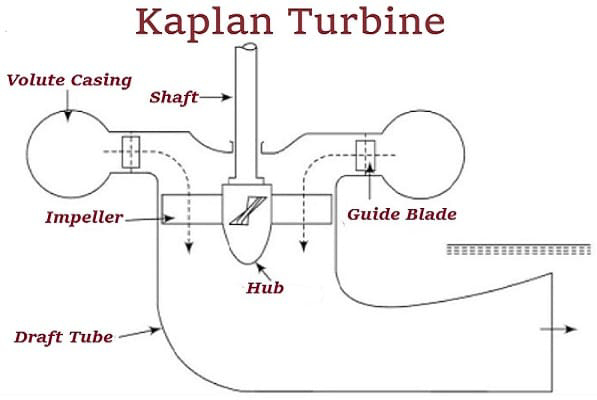Water Turbine :
A rotating machine which is used to convert the energy of falling water into mechanical energy is known as water turbine.
• These are used mostly in the dams for the generation of electric power using the potential energy of the fluid.
Classification of Water Turbines :
1. According to the type of energy at inlet:
(i) Impulse Turbine
(a) Pelton Wheel / Pelton Turbine
(ii) Reaction Turbine
(a) Francis Turbine
(b) Kaplan Turbine
2. According to the direction of flow through runner:
(i) Tangential Flow Turbine
(ii) Radial Flow Turbine
(a) Inward Radial Flow Turbine
(b) Outward Radial Flow Turbine
(iii) Axial Flow Turbine
(iv) Mixed Flow Turbine.
3. According to the head at the inlet of turbine:
(i) Low Head Turbine
(ii) Medium Head Turbine
(iii) High Head Turbine
4. According to the specific speed of the turbine:
(i) Low Specific Speed Turbine
(ii) Medium Specific Speed Turbine
(iii) High Specific Speed Turbine
1. According to the type of energy at inlet:
(i) Impulse turbine :
• If at the inlet of the turbine, the energy available is only kinetic energy, the turbine is known as impulse turbine.
• In an impulse turbine, the entire pressure of water is converted into kinetic energy in a nozzle and the velocity of the water jet drives the turbine wheel.
• Impulse turbines are used for high heads.
(a) Pelton Wheel / Pelton Turbine :
(ii) Reaction Turbine :
• If at the inlet of the turbine, the water possesses kinetic energy as well as pressure energy. the turbine is known as reaction turbine.
(a) Francis Turbine :
• They work on two flow patterns namely radial and axial flow concepts.
•Working :
1. Water enters the turbine through the penstock and flows into the spiral casing which directs the water towards the runner blades.
2. As the water flows through propeller with adjustable blades, it causes them to rotate.
3. The rotation of the runner blades turns the shaft connected to the generator, which produces electricity.
4. The water then exits the turbine through the draft tube and is discharged back into the river or other water body.
(b) Kaplan Turbine :
• Working :
1. Water enters the turbine to flow through penstock and flows into the spiral casing, which directs the water towards the stationary guide vanes.
2. The guide vanes direct the water onto the runner blades, causing the blades to rotate.
3. The rotation of the runner blades turns the shaft connected to the generator, which produces electricity.
4. The water then exits the turbine through the draft tube and is discharged back into the river or other water body.
2. According to the direction of flow through runner :
(i) Tangential Flow Turbine :
• If the water flows along the tangent of the runner, the turbine is known as tangential flow turbine.
• Ex - Pelton Wheel Turbine
(ii) Radial Flow Turbine :
• If the water flows in the radial direction through the runner, the turbine is called radial flow turbine.
• Ex - Francis Turbine
(a) Inward Radial Flow Turbine :
• If the water flows from outwards to inwards radially, the turbine is known as inward radial flow turbine.
(b) Outward Radial Flow Turbine :
• If water flows from inwards to outwards radially, the turbine is known as outward radial flow turbine.
(iii) Axial Flow Turbine :
• If the water flows through the runner along the direction parallel to the axis of rotation of the runner, the turbine is called axial flow turbine.
• Ex - Kaplan & Propeller Turbine
(iv) Mixed Flow Turbine :
• If the water flows through the runner in the radial direction but leaves in the direction parallel to axis of rotation of the runner, the turbine is called mixed flow turbine.
• Ex - Francis Turbine
3. According to the head at the inlet of turbine:
(i) Low Head Turbine :
• Turbines operating in the head range of fewer than 45 meters are considered low-head turbines.
• Ex - Kaplan Turbine
(ii) Medium Head Turbine :
• Turbines operating in the head range of 45 - 250 meters are considered medium-head turbines.
• Ex - Francis Turbine
(i) High Head Turbine :
• Turbines operating in the head higher than 250 meters are considered high-head turbines.
• Ex - Pelton Wheel Turbine
4. According to the specific speed of the turbine:
(i) Low Specific Speed Turbine :
• Turbines that operate in the specific speed range of 1 and 10 are considered as low specific speed Turbines.
• Ex - Pelton Wheel Turbine
(ii) Medium Specific Speed Turbine :
• Turbines that operate in the specific speed range of 10 to 100 are considered as Medium Specific Speed Turbines.
• Ex - Francis Turbine
(iii) High Specific Speed Turbine :
• Turbines that operate in the specific speed above 100 are considered as High Specific Speed Turbines.
• Ex - Kaplan Turbine







